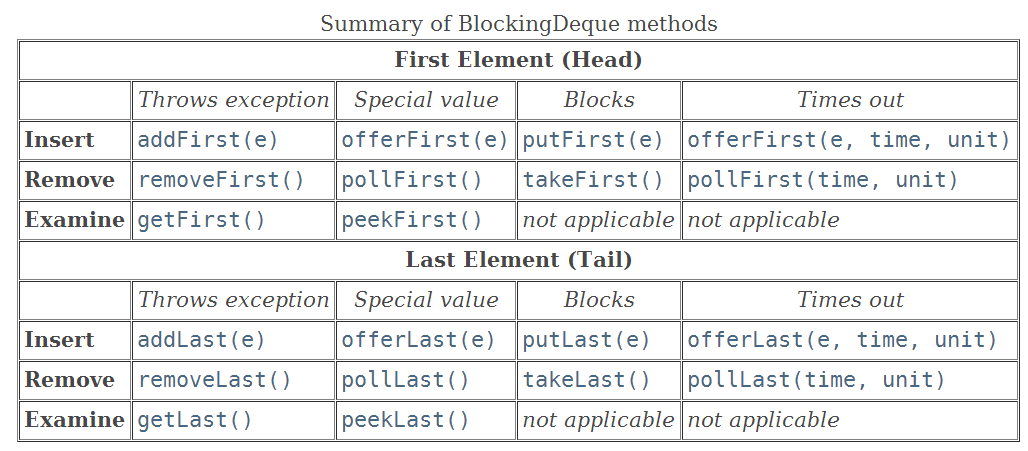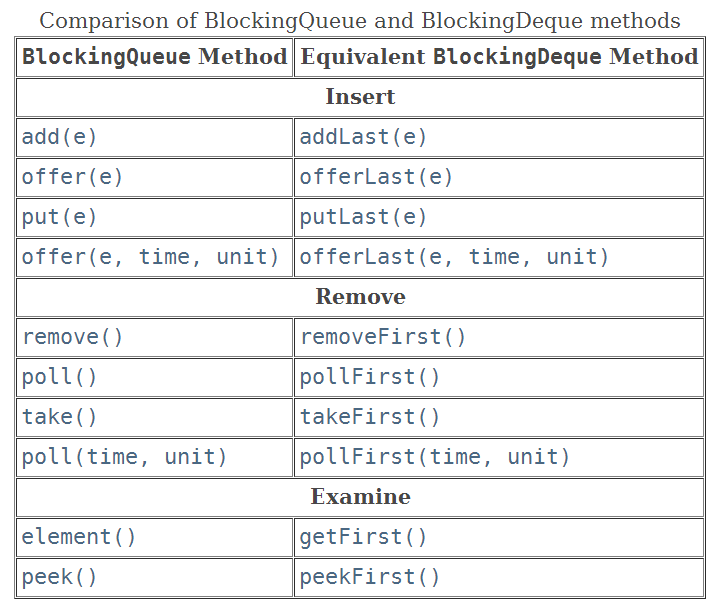content: Java,并发编程,多线程,Thread,BlockingQueue
title: 吊打Java并发面试官之BlockingQueue shortTitle: BlockingQueue description: 吊打Java并发面试官之BlockingQueue category: - Java核心 tag: - Java并发编程 head: - - meta - name: keywords
content: Java,并发编程,多线程,Thread,BlockingQueue
最常用的”生产者-消费者“问题中,队列通常被视作线程间操作的数据容器,这样,可以对各个模块的业务功能进行解耦,生产者将“生产”出来的数据放置在数据容器中,而消费者仅仅只需要在“数据容器”中进行获取数据即可,这样生产者线程和消费者线程就能够进行解耦,只专注于自己的业务功能即可。
阻塞队列(BlockingQueue)被广泛使用在“生产者-消费者”问题中,其原因是BlockingQueue提供了可阻塞的插入和移除的方法。当队列容器已满,生产者线程会被阻塞,直到队列未满;当队列容器为空时,消费者线程会被阻塞,直至队列非空时为止。
基本操作
BlockingQueue基本操作总结如下(此图来源于JAVA API文档):

BlockingQueue继承于Queue接口,因此,对数据元素的基本操作有:
1)插入元素
- add(E e) :往队列插入数据,当队列满时,插入元素时会抛出IllegalStateException异常;
- offer(E e):当往队列插入数据时,插入成功返回
true,否则则返回false。当队列满时不会抛出异常;
2)删除元素
- remove(Object o):从队列中删除数据,成功则返回
true,否则为false - poll:删除数据,当队列为空时,返回null;
3)查看元素
- element:获取队头元素,如果队列为空时则抛出NoSuchElementException异常;
- peek:获取队头元素,如果队列为空则抛出NoSuchElementException异常
BlockingQueue具有的特殊操作:
1)插入数据:
- put:当阻塞队列容量已经满时,往阻塞队列插入数据的线程会被阻塞,直至阻塞队列已经有空余的容量可供使用;
offer(E e, long timeout, TimeUnit unit):若阻塞队列已经满时,同样会阻塞插入数据的线程,直至阻塞队列已经有空余的地方,与put方法不同的是,该方法会有一个超时时间,若超过当前给定的超时时间,插入数据的线程会退出;
2)删除数据
take():当阻塞队列为空时,获取队头数据的线程会被阻塞;poll(long timeout, TimeUnit unit):当阻塞队列为空时,获取数据的线程会被阻塞,另外,如果被阻塞的线程超过了给定的时长,该线程会退出
常用的BlockingQueue
实现BlockingQueue接口的有ArrayBlockingQueue, DelayQueue, LinkedBlockingDeque, LinkedBlockingQueue, LinkedTransferQueue, PriorityBlockingQueue, SynchronousQueue,而这几种常见的阻塞队列也是在实际编程中会常用的,下面对这几种常见的阻塞队列进行说明:
ArrayBlockingQueue
ArrayBlockingQueue是由数组实现的有界阻塞队列。该队列命令元素FIFO(先进先出)。因此,对头元素时队列中存在时间最长的数据元素,而对尾数据则是当前队列最新的数据元素。ArrayBlockingQueue可作为“有界数据缓冲区”,生产者插入数据到队列容器中,并由消费者提取。ArrayBlockingQueue一旦创建,容量不能改变。
当队列容量满时,尝试将元素放入队列将导致操作阻塞;尝试从一个空队列中取一个元素也会同样阻塞。
ArrayBlockingQueue默认情况下不能保证线程访问队列的公平性,所谓公平性是指严格按照线程等待的绝对时间顺序,即最先等待的线程能够最先访问到ArrayBlockingQueue。而非公平性则是指访问ArrayBlockingQueue的顺序不是遵守严格的时间顺序,有可能存在,一旦ArrayBlockingQueue可以被访问时,长时间阻塞的线程依然无法访问到ArrayBlockingQueue。如果保证公平性,通常会降低吞吐量。如果需要获得公平性的ArrayBlockingQueue,可采用如下代码:
private static ArrayBlockingQueue<Integer> blockingQueue = new ArrayBlockingQueue<Integer>(10,true);
ArrayBlockingQueue的主要属性如下:
/** The queued items */
final Object[] items;
/** items index for next take, poll, peek or remove */
int takeIndex;
/** items index for next put, offer, or add */
int putIndex;
/** Number of elements in the queue */
int count;
/*
* Concurrency control uses the classic two-condition algorithm
* found in any textbook.
*/
/** Main lock guarding all access */
final ReentrantLock lock;
/** Condition for waiting takes */
private final Condition notEmpty;
/** Condition for waiting puts */
private final Condition notFull;
从源码中可以看出ArrayBlockingQueue内部是采用数组进行数据存储的(属性items),为了保证线程安全,采用的是ReentrantLock lock,为了保证可阻塞式的插入删除数据利用的是Condition,当获取数据的消费者线程被阻塞时会将该线程放置到notEmpty等待队列中,当插入数据的生产者线程被阻塞时,会将该线程放置到notFull等待队列中。而notEmpty和notFull等中要属性在构造方法中进行创建:
public ArrayBlockingQueue(int capacity, boolean fair) {
if (capacity <= 0)
throw new IllegalArgumentException();
this.items = new Object[capacity];
lock = new ReentrantLock(fair);
notEmpty = lock.newCondition();
notFull = lock.newCondition();
}
接下来,主要看看可阻塞式的put和take方法是怎样实现的。
1)put方法详解
put(E e)方法源码如下:
public void put(E e) throws InterruptedException {
checkNotNull(e);
final ReentrantLock lock = this.lock;
lock.lockInterruptibly();
try {
//如果当前队列已满,将线程移入到notFull等待队列中
while (count == items.length)
notFull.await();
//满足插入数据的要求,直接进行入队操作
enqueue(e);
} finally {
lock.unlock();
}
}
该方法的逻辑很简单,当队列已满时(count == items.length)将线程移入到notFull等待队列中,如果当前满足插入数据的条件,就可以直接调用enqueue(e)插入数据元素。enqueue方法源码为:
private void enqueue(E x) {
// assert lock.getHoldCount() == 1;
// assert items[putIndex] == null;
final Object[] items = this.items;
//插入数据
items[putIndex] = x;
if (++putIndex == items.length)
putIndex = 0;
count++;
//通知消费者线程,当前队列中有数据可供消费
notEmpty.signal();
}
enqueue方法的逻辑同样也很简单,先完成插入数据,即往数组中添加数据(items[putIndex] = x),然后通知被阻塞的消费者线程,当前队列中有数据可供消费(notEmpty.signal())。
2)take方法详解
take方法源码如下:
public E take() throws InterruptedException {
final ReentrantLock lock = this.lock;
lock.lockInterruptibly();
try {
//如果队列为空,没有数据,将消费者线程移入等待队列中
while (count == 0)
notEmpty.await();
//获取数据
return dequeue();
} finally {
lock.unlock();
}
}
take方法也主要做了两步:
- 如果当前队列为空的话,则将获取数据的消费者线程移入到等待队列中;
- 若队列不为空则获取数据,即完成出队操作
dequeue。dequeue方法源码为:
private E dequeue() {
// assert lock.getHoldCount() == 1;
// assert items[takeIndex] != null;
final Object[] items = this.items;
@SuppressWarnings("unchecked")
//获取数据
E x = (E) items[takeIndex];
items[takeIndex] = null;
if (++takeIndex == items.length)
takeIndex = 0;
count--;
if (itrs != null)
itrs.elementDequeued();
//通知被阻塞的生产者线程
notFull.signal();
return x;
}
dequeue方法也主要做了两件事情:
- 获取队列中的数据,即获取数组中的数据元素(
(E) items[takeIndex]); - 通知notFull等待队列中的线程,使其由等待队列移入到同步队列中,使其能够有机会获得lock,并执行完成功退出。
从以上分析,可以看出put和take方法主要是通过condition的通知机制来完成可阻塞式的插入数据和获取数据。在理解ArrayBlockingQueue后再去理解LinkedBlockingQueue就很容易了。
LinkedBlockingQueue
LinkedBlockingQueue是用链表实现的有界阻塞队列,同样满足FIFO的特性,与ArrayBlockingQueue相比起来具有更高的吞吐量,为了防止LinkedBlockingQueue容量迅速增,损耗大量内存。通常在创建LinkedBlockingQueue对象时,会指定其大小,如果未指定,容量等于Integer.MAX_VALUE
LinkedBlockingQueue的主要属性有:
/** Current number of elements */
private final AtomicInteger count = new AtomicInteger();
/**
* Head of linked list.
* Invariant: head.item == null
*/
transient Node<E> head;
/**
* Tail of linked list.
* Invariant: last.next == null
*/
private transient Node<E> last;
/** Lock held by take, poll, etc */
private final ReentrantLock takeLock = new ReentrantLock();
/** Wait queue for waiting takes */
private final Condition notEmpty = takeLock.newCondition();
/** Lock held by put, offer, etc */
private final ReentrantLock putLock = new ReentrantLock();
/** Wait queue for waiting puts */
private final Condition notFull = putLock.newCondition();
可以看出与ArrayBlockingQueue主要的区别是,LinkedBlockingQueue在插入数据和删除数据时分别是由两个不同的lock(takeLock和putLock)来控制线程安全的,因此,也由这两个lock生成了两个对应的condition(notEmpty和notFull)来实现可阻塞的插入和删除数据。并且,采用了链表的数据结构来实现队列,Node结点的定义为:
static class Node<E> {
E item;
/**
* One of:
* - the real successor Node
* - this Node, meaning the successor is head.next
* - null, meaning there is no successor (this is the last node)
*/
Node<E> next;
Node(E x) { item = x; }
}
接下来,我们也同样来看看put方法和take方法的实现。
1)put方法详解
put方法源码为:
public void put(E e) throws InterruptedException {
if (e == null) throw new NullPointerException();
// Note: convention in all put/take/etc is to preset local var
// holding count negative to indicate failure unless set.
int c = -1;
Node<E> node = new Node<E>(e);
final ReentrantLock putLock = this.putLock;
final AtomicInteger count = this.count;
putLock.lockInterruptibly();
try {
/*
* Note that count is used in wait guard even though it is
* not protected by lock. This works because count can
* only decrease at this point (all other puts are shut
* out by lock), and we (or some other waiting put) are
* signalled if it ever changes from capacity. Similarly
* for all other uses of count in other wait guards.
*/
//如果队列已满,则阻塞当前线程,将其移入等待队列
while (count.get() == capacity) {
notFull.await();
}
//入队操作,插入数据
enqueue(node);
c = count.getAndIncrement();
//若队列满足插入数据的条件,则通知被阻塞的生产者线程
if (c + 1 < capacity)
notFull.signal();
} finally {
putLock.unlock();
}
if (c == 0)
signalNotEmpty();
}
put方法的逻辑也同样很容易理解,可见注释。基本上和ArrayBlockingQueue的put方法一样。
2)take方法
源码如下:
public E take() throws InterruptedException {
E x;
int c = -1;
final AtomicInteger count = this.count;
final ReentrantLock takeLock = this.takeLock;
takeLock.lockInterruptibly();
try {
//当前队列为空,则阻塞当前线程,将其移入到等待队列中,直至满足条件
while (count.get() == 0) {
notEmpty.await();
}
//移除队头元素,获取数据
x = dequeue();
c = count.getAndDecrement();
//如果当前满足移除元素的条件,则通知被阻塞的消费者线程
if (c > 1)
notEmpty.signal();
} finally {
takeLock.unlock();
}
if (c == capacity)
signalNotFull();
return x;
}
take方法的主要逻辑请见于注释,也很容易理解。
** ArrayBlockingQueue与LinkedBlockingQueue的比较**
相同点:ArrayBlockingQueue和LinkedBlockingQueue都是通过condition通知机制来实现可阻塞式插入和删除元素,并满足线程安全的特性;
不同点:
- ArrayBlockingQueue底层是采用的数组进行实现,而LinkedBlockingQueue则是采用链表数据结构;
- ArrayBlockingQueue插入和删除数据,只采用了一个lock,而LinkedBlockingQueue则是在插入和删除分别采用了
putLock和takeLock,这样可以降低线程由于线程无法获取到lock而进入WAITING状态的可能性,从而提高了线程并发执行的效率。
PriorityBlockingQueue
PriorityBlockingQueue是一个支持优先级的无界阻塞队列。默认情况下元素采用自然顺序进行排序,也可以通过自定义类实现compareTo()方法来指定元素排序规则,或者初始化时通过构造器参数Comparator来指定排序规则。
SynchronousQueue
SynchronousQueue每个插入操作必须等待另一个线程进行相应的删除操作,因此,SynchronousQueue实际上没有存储任何数据元素,因为只有线程在删除数据时,其他线程才能插入数据,同样的,如果当前有线程在插入数据时,线程才能删除数据。SynchronousQueue也可以通过构造器参数来为其指定公平性。
LinkedTransferQueue
LinkedTransferQueue是一个由链表数据结构构成的无界阻塞队列,由于该队列实现了TransferQueue接口,与其他阻塞队列相比主要有以下不同的方法:
transfer(E e) 如果当前有线程(消费者)正在调用take()方法或者可延时的poll()方法进行消费数据时,生产者线程可以调用transfer方法将数据传递给消费者线程。如果当前没有消费者线程的话,生产者线程就会将数据插入到队尾,直到有消费者能够进行消费才能退出;
tryTransfer(E e)
tryTransfer方法如果当前有消费者线程(调用take方法或者具有超时特性的poll方法)正在消费数据的话,该方法可以将数据立即传送给消费者线程,如果当前没有消费者线程消费数据的话,就立即返回false。因此,与transfer方法相比,transfer方法是必须等到有消费者线程消费数据时,生产者线程才能够返回。而tryTransfer方法能够立即返回结果退出。
tryTransfer(E e,long timeout,imeUnit unit)
与transfer基本功能一样,只是增加了超时特性,如果数据才规定的超时时间内没有消费者进行消费的话,就返回false。
LinkedBlockingDeque
LinkedBlockingDeque是基于链表数据结构的有界阻塞双端队列,如果在创建对象时为指定大小时,其默认大小为Integer.MAX_VALUE。与LinkedBlockingQueue相比,主要的不同点在于,LinkedBlockingDeque具有双端队列的特性。LinkedBlockingDeque基本操作如下图所示(来源于java文档)

如上图所示,LinkedBlockingDeque的基本操作可以分为四种类型:
- 特殊情况,抛出异常;
- 特殊情况,返回特殊值如null或者false;
- 当线程不满足操作条件时,线程会被阻塞直至条件满足;
- 操作具有超时特性。
另外,LinkedBlockingDeque实现了BlockingDueue接口而LinkedBlockingQueue实现的是BlockingQueue,这两个接口的主要区别如下图所示(来源于java文档):

从上图可以看出,两个接口的功能是可以等价使用的,比如BlockingQueue的add方法和BlockingDeque的addLast方法的功能是一样的。
DelayQueue
DelayQueue是一个存放实现Delayed接口的数据的无界阻塞队列,只有当数据对象的延时时间达到时才能插入到队列进行存储。如果当前所有的数据都还没有达到创建时所指定的延时期,则队列没有队头,并且线程通过poll等方法获取数据元素则返回null。所谓数据延时期满时,则是通过Delayed接口的getDelay(TimeUnit.NANOSECONDS)来进行判定,如果该方法返回的是小于等于0则说明该数据元素的延时期已满。
编辑:沉默王二,内容大部分来源以下三个开源仓库: - 深入浅出 Java 多线程 - 并发编程知识总结 - Java八股文
你可能感兴趣的文章
content: Java,并发编程,多线程,Thread,ConcurrentHashMap
content: Java,并发编程,多线程,Thread,ConcurrentLinkedQueue
content: Java,并发编程,多线程,Thread,CopyOnWriteArrayList